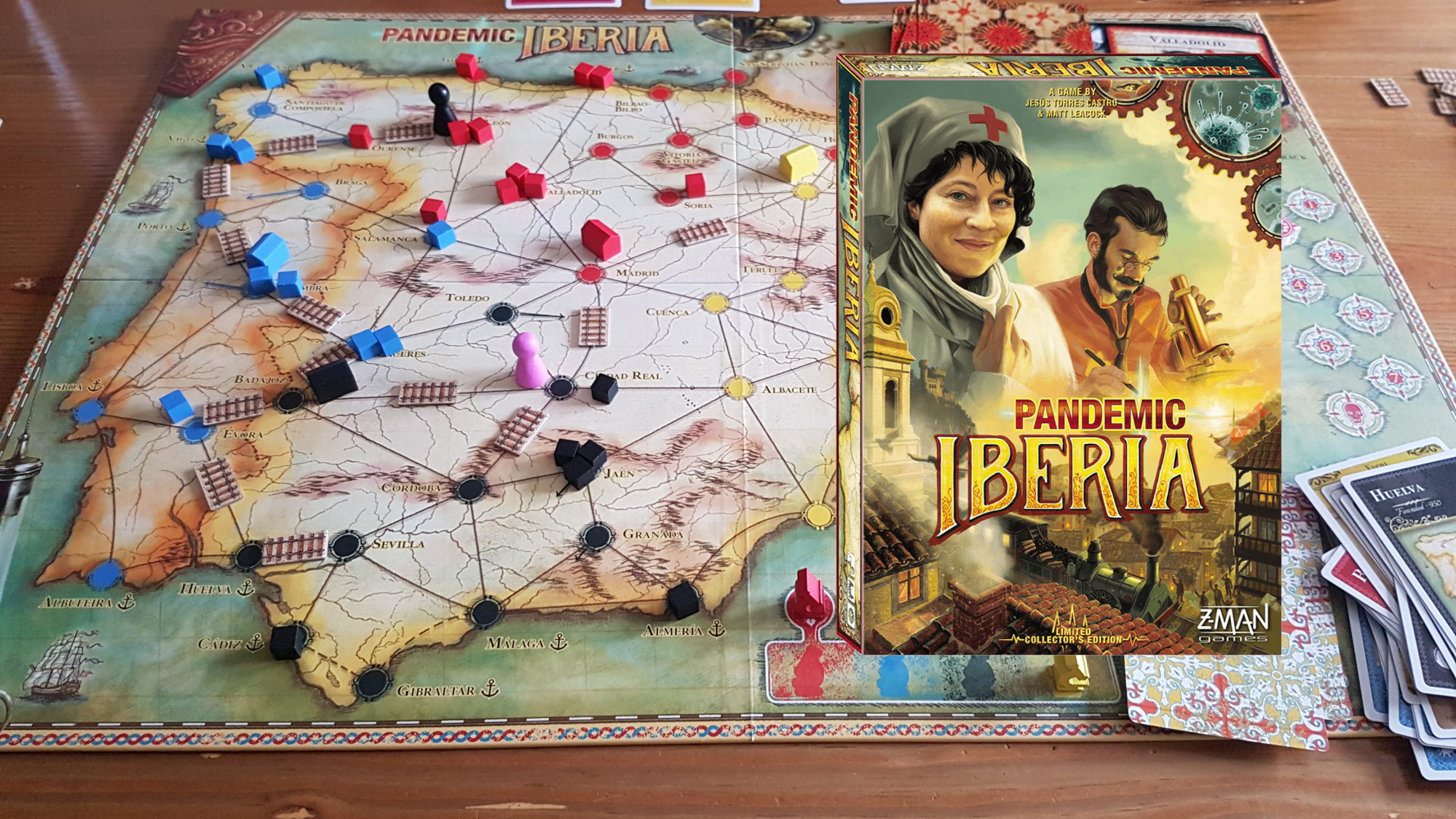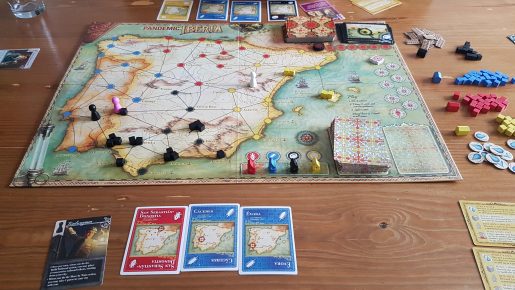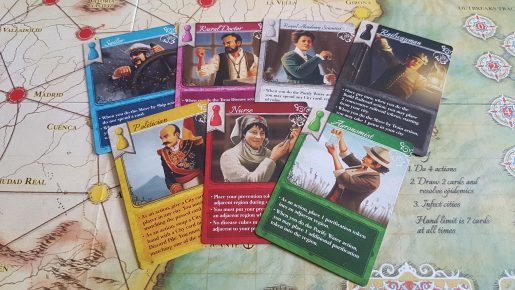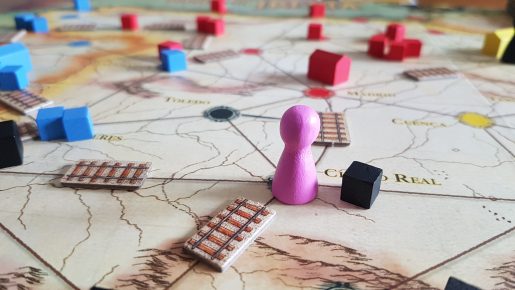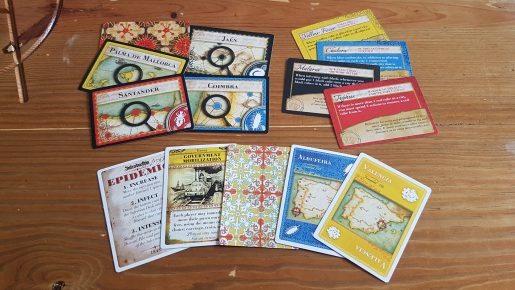Pandemic Iberia is a cooperative board game set in the Iberian Peninsula in 1848, published by Z-Man Games. Designed by Jesús Torres Castro and Matt Leacock, Pandemic Iberia sees 2 – 5 players take around 45 – 60 minutes trying to cure diseases across the region of Portugal and Spain. Gone are the modern viruses seen in the original 2008 title, Pandemic, with the fight to cure malaria, typhus, yellow fever and cholera the aim for the players. However, is Pandemic Iberia in need of a cure itself? Let’s find out!
Pandemic Iberia can be played in multiple ways, all of which are cooperative: utilizing the original Pandemic system with the addition of purified water and railways, fighting against historical diseases or a patients challenge. The regular mode retains the goal of finding the cure to 4 diseases. Players can lose if 8 outbreaks occur, players run out of an individual disease colour or the player card deck is depleted before the 4 cures are researched. Each turn is made up of three phases; actions, draw player cards and infect.
Like the rest of the series Pandemic Iberia utilizes an action point system. This means on a players turn they have a list of available actions but they can only afford to do so many. With four actions a turn players can spend these to do any of the following in any order: move, treat a disease, research a disease, build a hospital, place purified water or build a railway.
The latter two actions are new actions so will stand out most to fans of the franchise. Railways can be built to speed up movement. Movement is slightly different from the original Pandemic, with flights not being a thing in the 19th century. Somewhat replacing this is the ability to charter a boat from one port to another and to move along connected railway sections. Getting a good railway system down early on can be key, especially for getting the cards to hospitals to research diseases.
Movement is great but controlling the diseases is more important and during the infect phase purified water can stop disease cubes being placed onto the board. Purified water costs a card, of colour of either a researched disease or of a city adjacent to a region. Spending the card puts two purified water tokens into the region; not onto an individual city. Whenever a disease cube should be added to a city in the region the purified water token is instead removed.
Both being beneficial of course there had to be a balancing feature; coming in the form of tweaked disease rules. Alas, while researching all 4 diseases will win you the game individually researched diseases isn’t as potent as in the original Pandemic. This is due to the thematic logic that these old world diseases at the time were merely prevented from spreading instead of being cured. So even when researched players must still spend an action point per cube to remove it from the board and that colour continues to spawn.
While water purification and railways add to the gameplay, distancing Pandemic Iberia somewhat from the original, the new variants Historical Diseases and Influx of Patients go above and beyond. Historical diseases changes one/some/all of the diseases from boring colours to represent Malaria (black), Cholera (blue), Yellow Fever (surprisingly yellow) and Typhus (red). Each of these real world diseases come with additional traits that make the game harder. For example, Malaria sees two cubes added to the board instead of one if it would be the only one in the city – making it more likely for black cubes to run out! Players will have to change up their strategy from game to game as they include the different disease traits. It would have been nice to see a few different traits per cube colour for added variety, though it isn’t like the included traits don’t add enough challenge!
In the Influx of Patients variant cubes no longer just represent diseases, instead each cube is effectively a diseased patient. Patients want to get cured and will slowly but surely move towards hospitals that are built around the board. This mode shakes things up further by adding in an additional phase each turn. After performing 4 actions and before drawing player cards players must move a patient of each colour. While building a hospital on a city will cure the disease cubes of that hospitals colour, patients charging towards hospitals isn’t a great thing. Even using railways to get to hospitals quicker patients can cause hospitals to get overrun, effectively causing an outbreak. It is certainly a novel change to have cubes moving around the board from one turn to the next and means players have another aspect to keep an eye on.
The component quality is as expected, solid like the rest of the Pandemic franchise. From the board to the cards the art style has been changed up to be more thematic and period-like, with small injections of colour that pop. The cards shuffle with ease and are of decent, normal, size. The only aspect which I have mixed feelings about are the cubes, used for patients/diseases. Put side by side with the original Pandemic’s cubes, made of transparent plastic, the wooden cubes of Iberia don’t look or feel as premium. This being said, the use of wood over plastic works so well with the time period it would stand out if the cubes were plastic.
Pandemic Iberia offers an interesting twist on the base game, whether you opt to play with the slight changes in “standard” Iberia or the Influx of Patients variant. On the surface railways and purified water make the game easier, be it by the ability to travel far along a continuous railway for only one action point or use knowledge to preemptively protect a future infection location. Thankfully, there are enough tweaks to keep players on their disease-ridden toes.
Concept wise the game is rather similar to Ticket to Ride expansions, though is standalone, with the location being changed and a handful of new rules being added in. Like with those variants I’d still introduce a new player into the franchise with the base game for ease of understanding. Conversely, Pandemic veterans will love the replayability instilled into the title with the different modes and setup options; which are ever so slightly reminiscent of the Legacy version, in the way each game can be slightly different. After the experience of Legacy I found it hard to return to base Pandemic, however Pandemic Iberia shows there is plenty of life left in the non-legacy variants of the franchise!
[Editor’s Note: Pandemic Iberia was provided to us by Asmodee UK for review purposes. The game is currently available on 365 Games for £24.99. It is also available from local UK board game stores, find your local store here]

